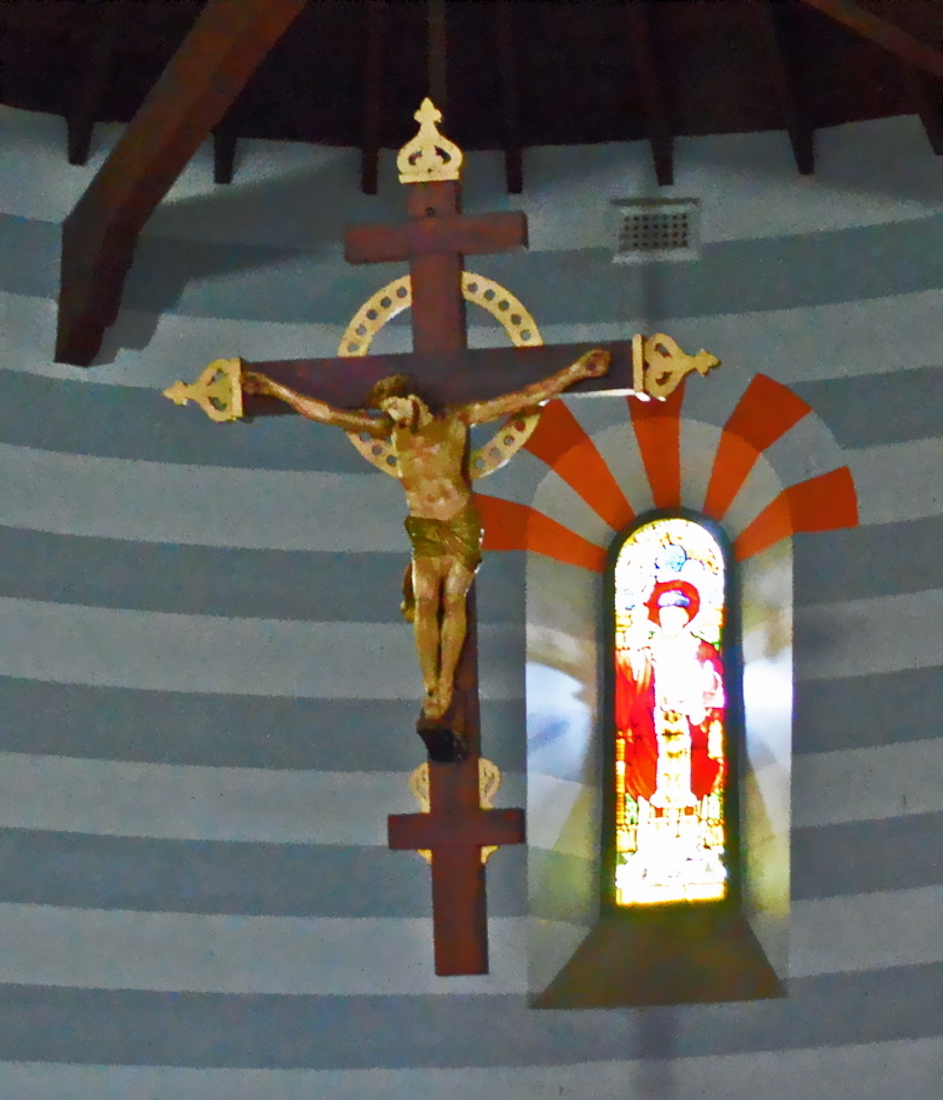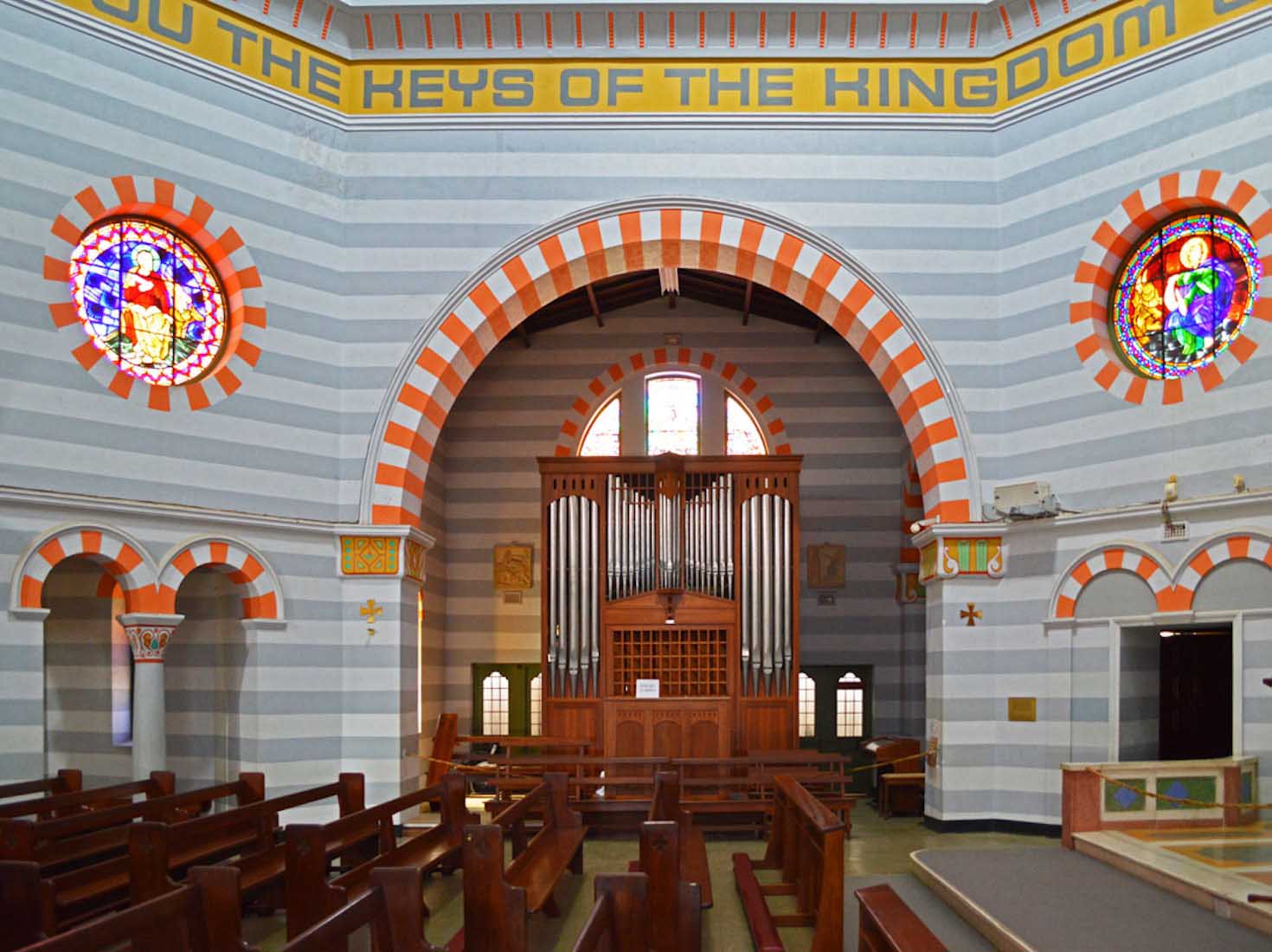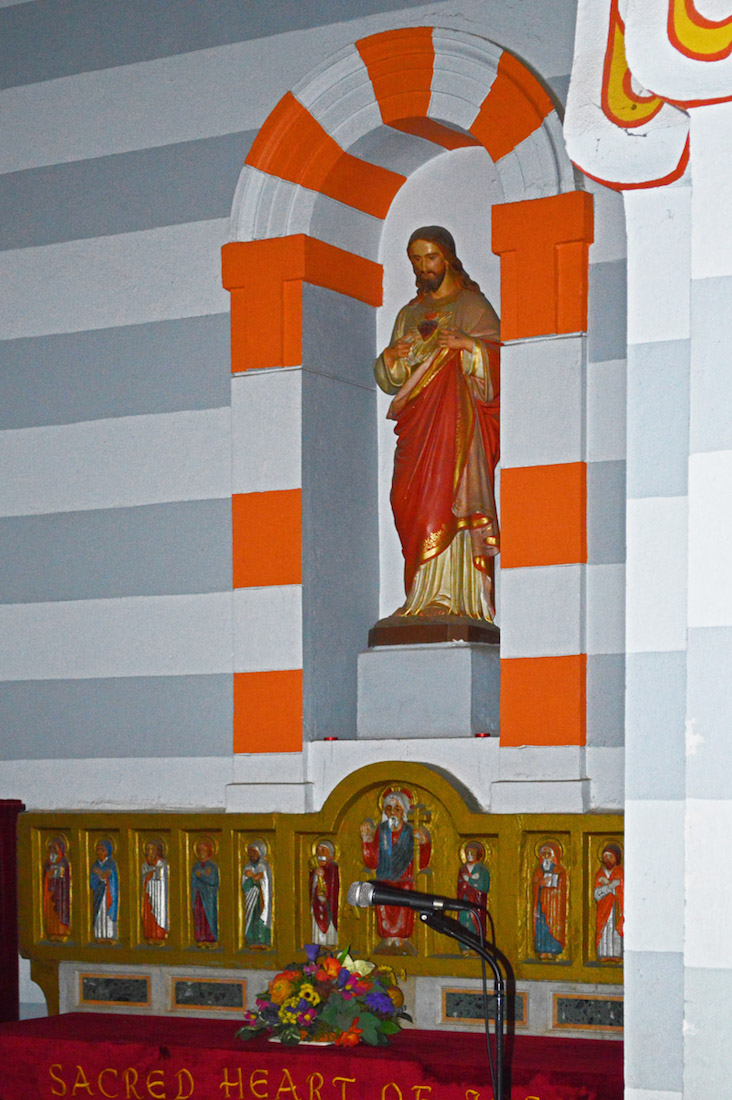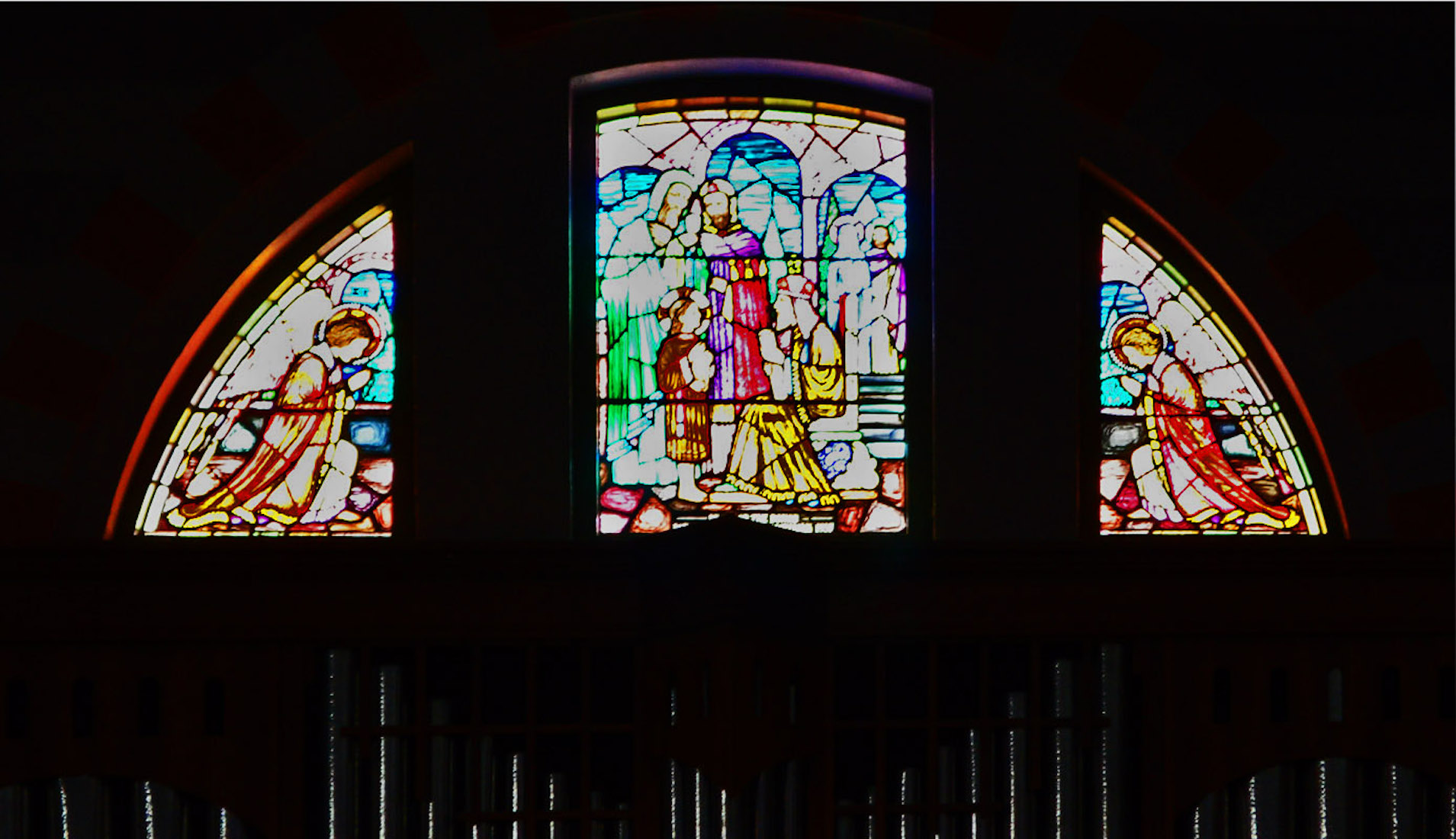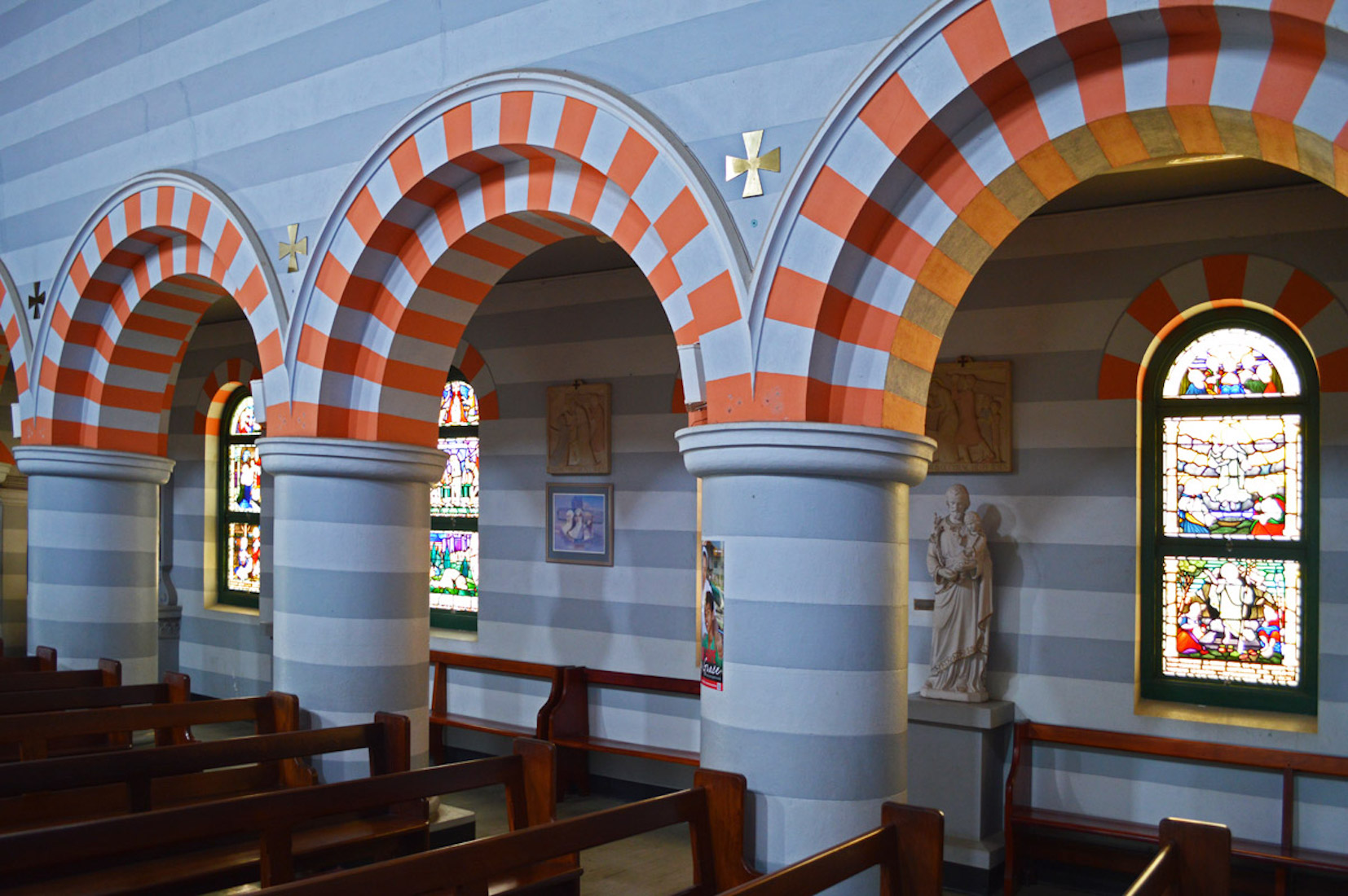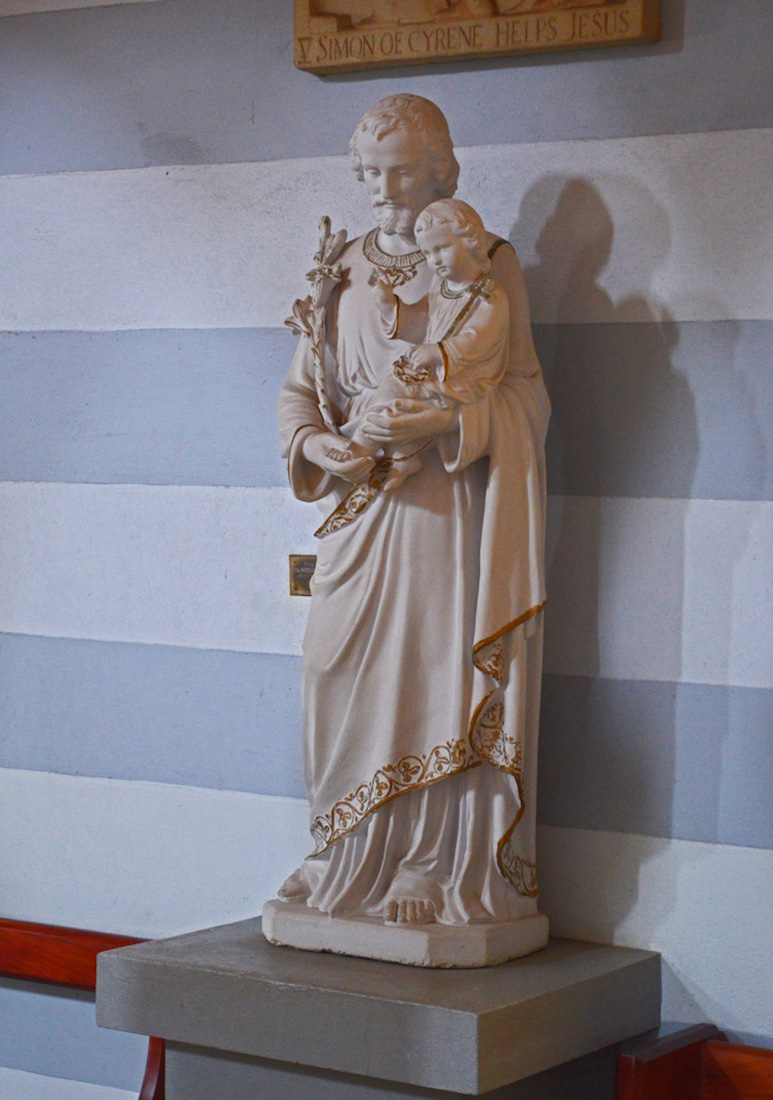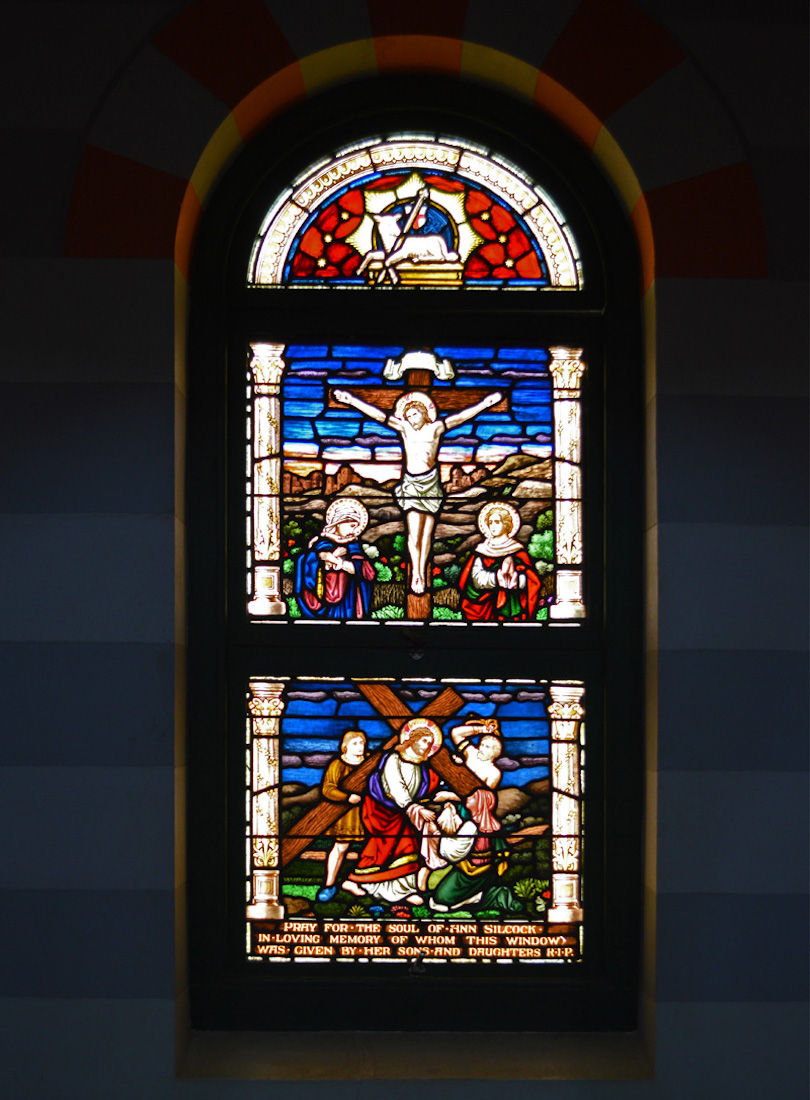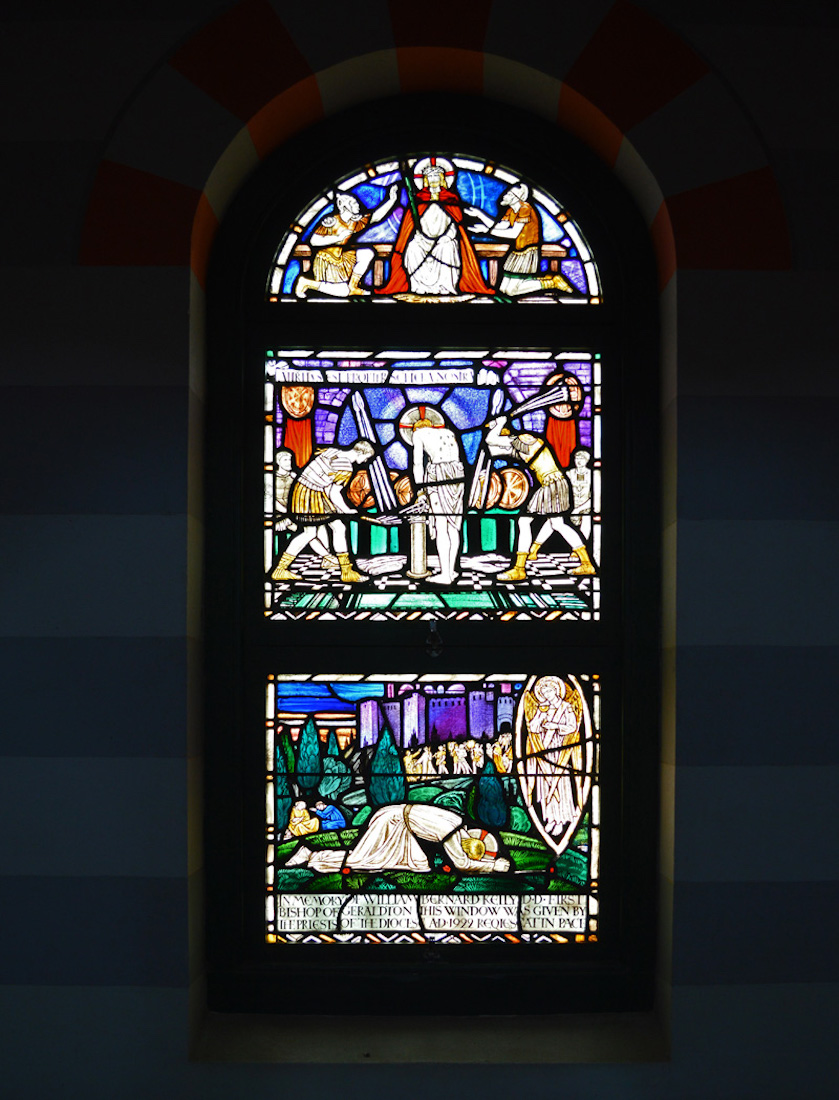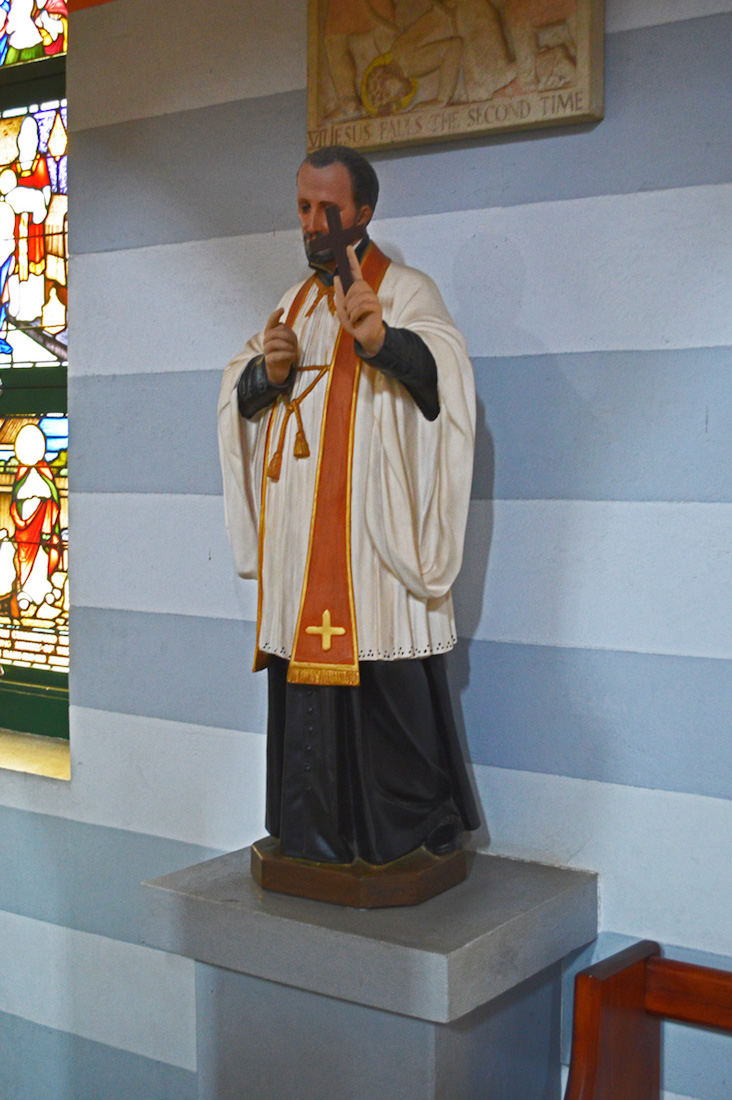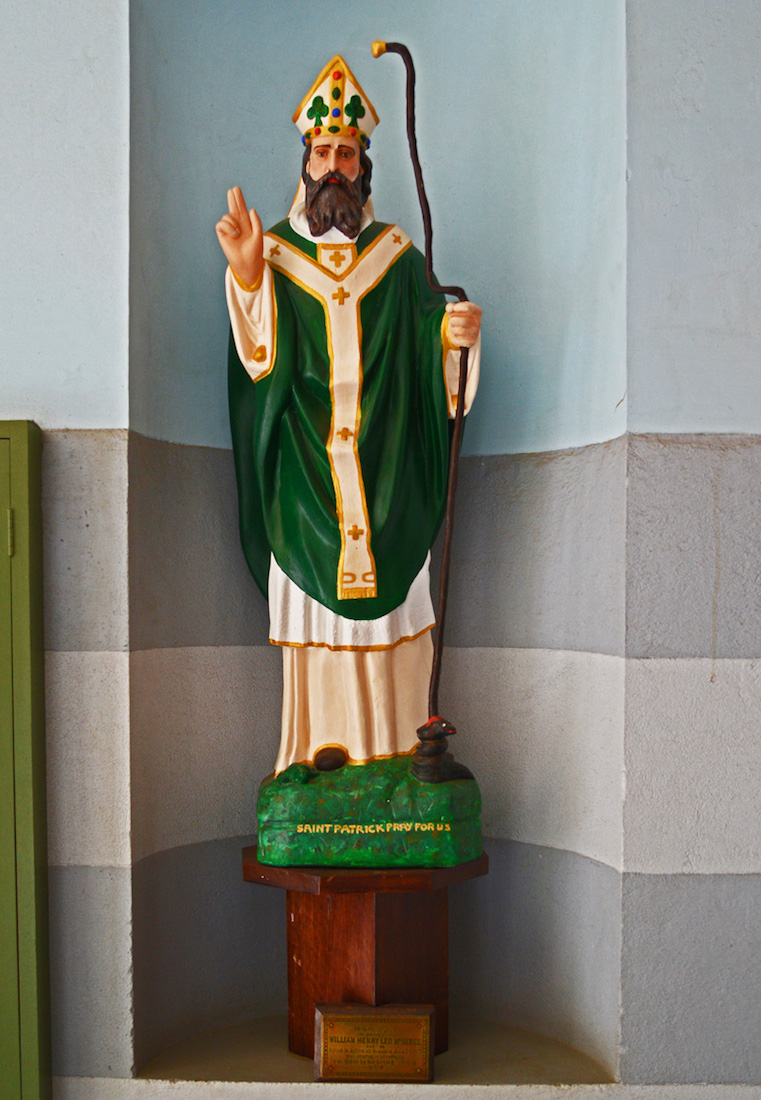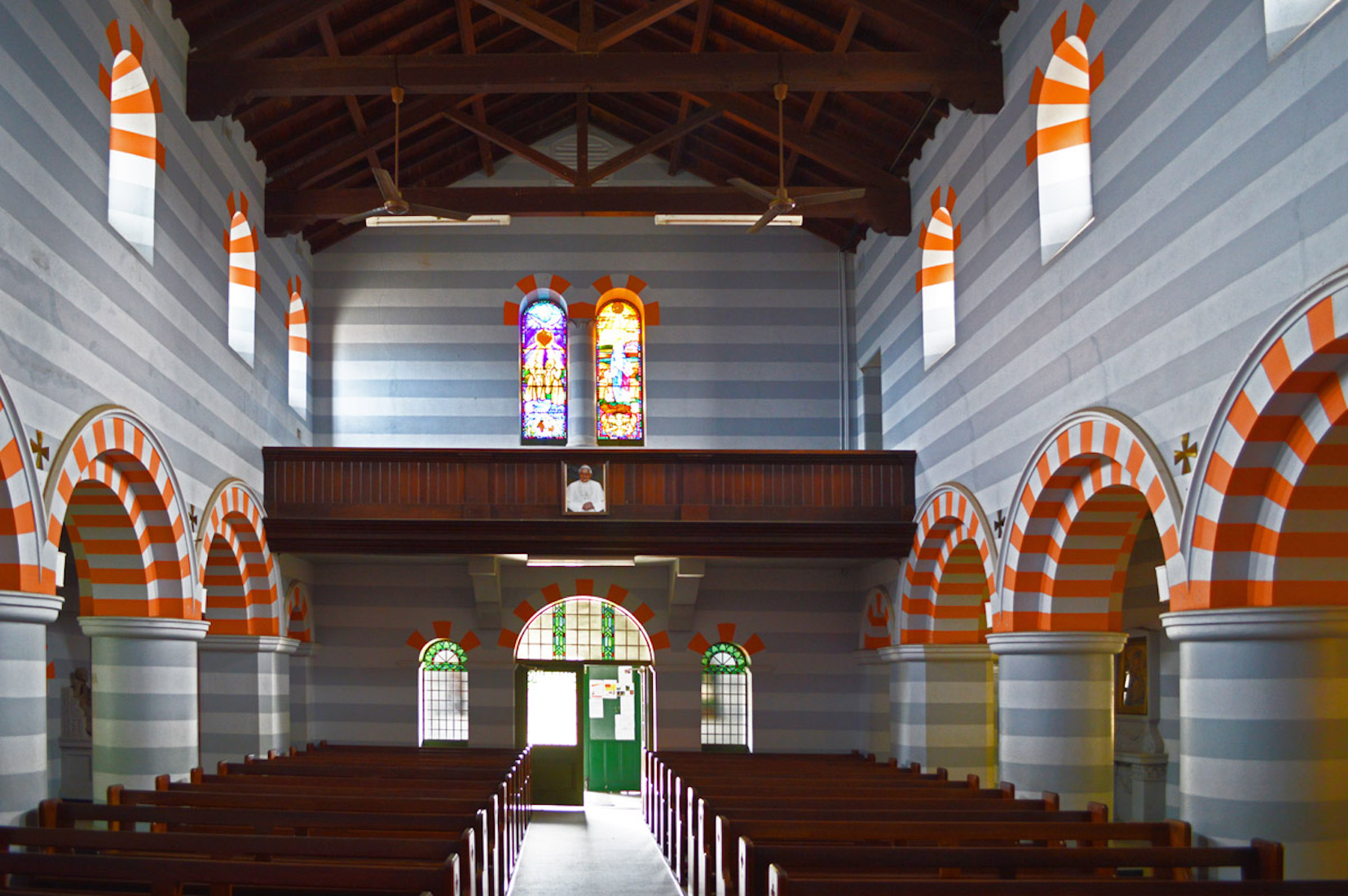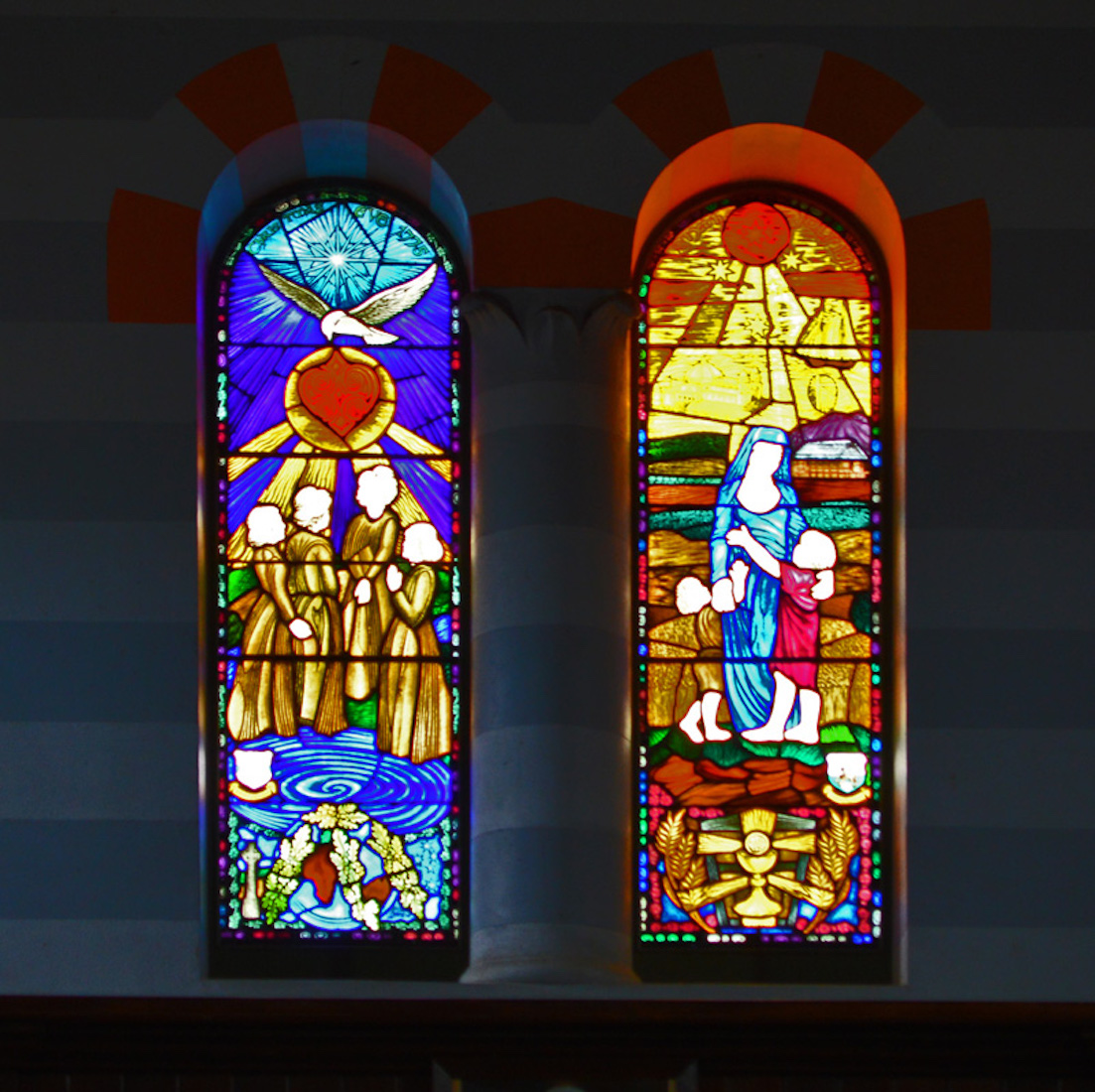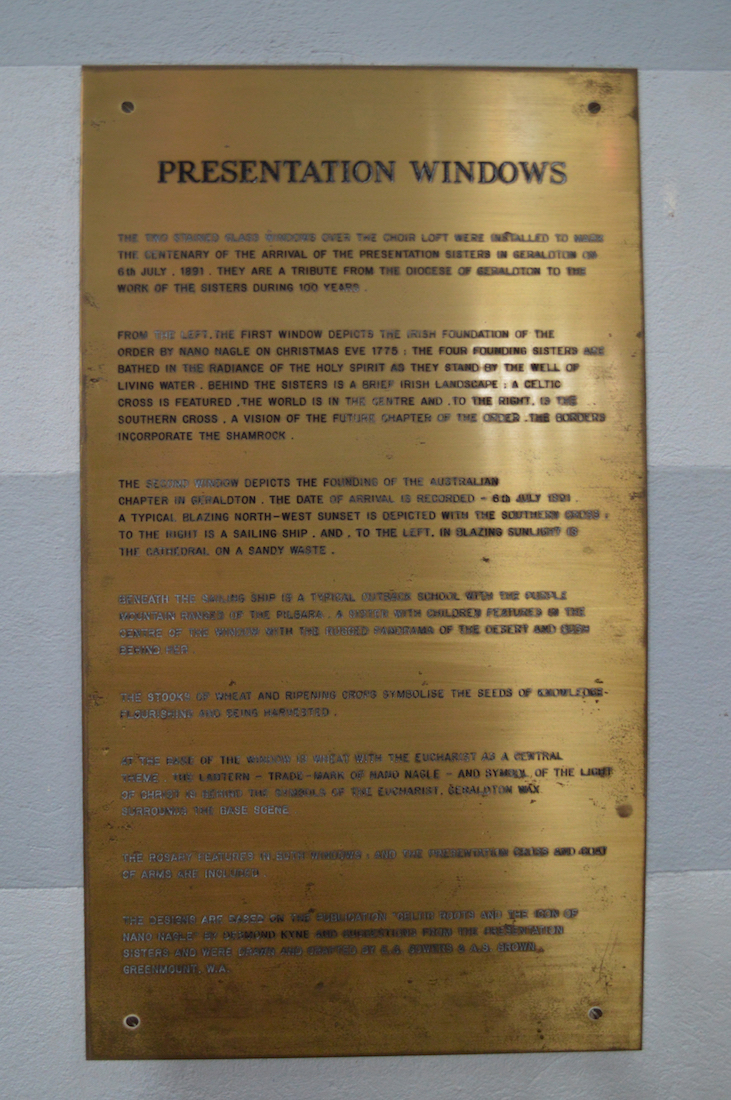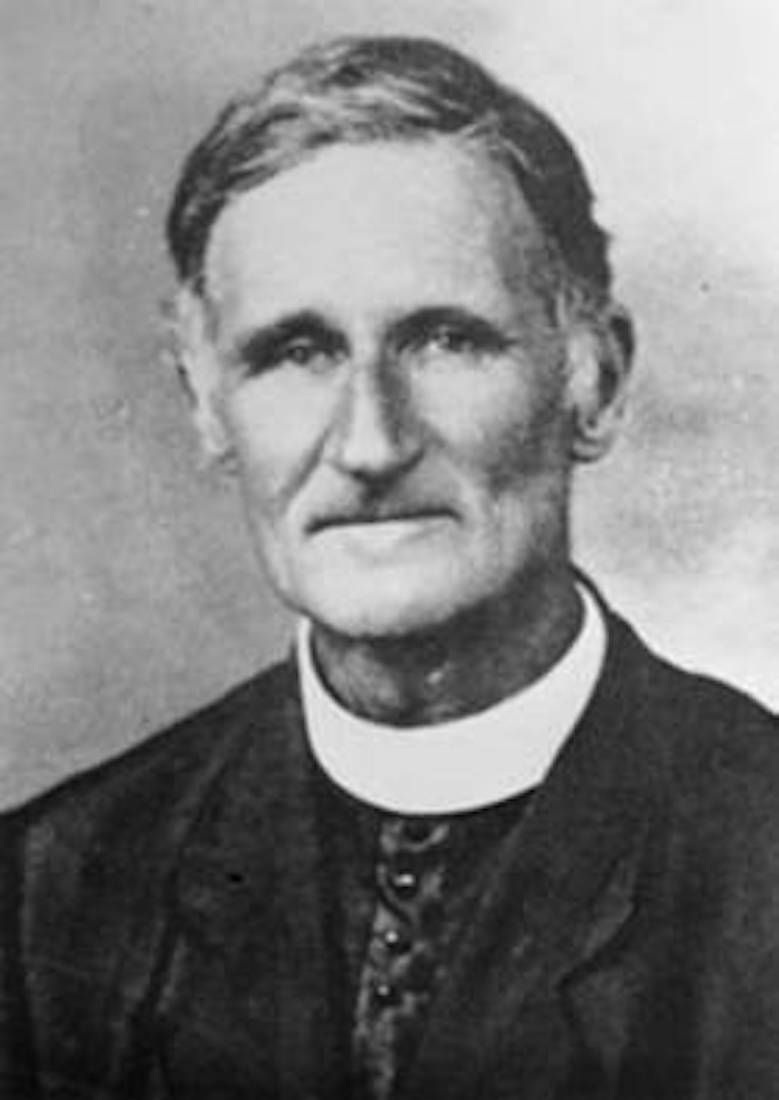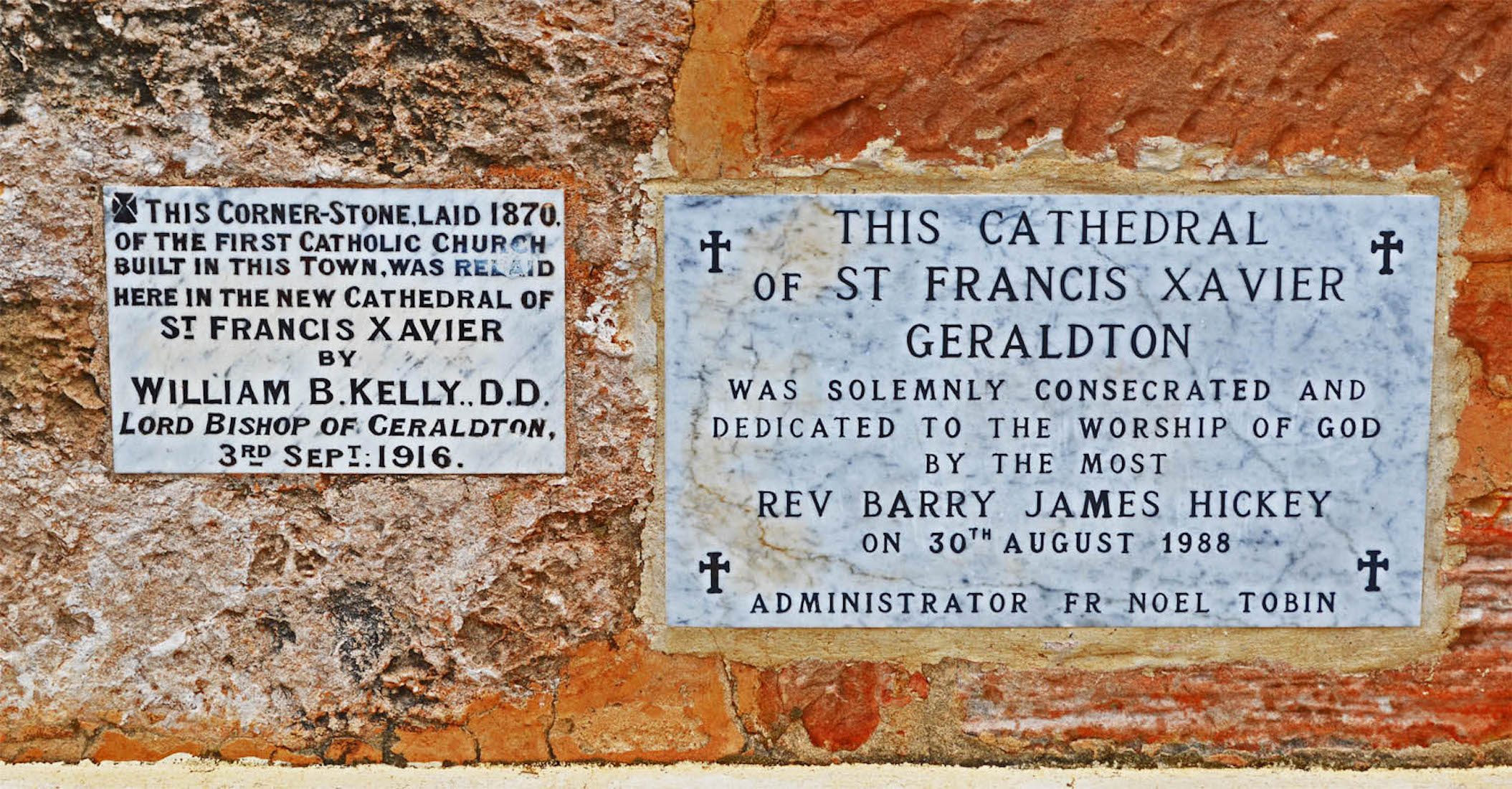
Adjacent to the tabernacle is a very smart chair and table. These are presumably used by the officiating clergy, but I am unsure whether they have any further ecclesiastical significance. INDEX
42. CATHEDRA
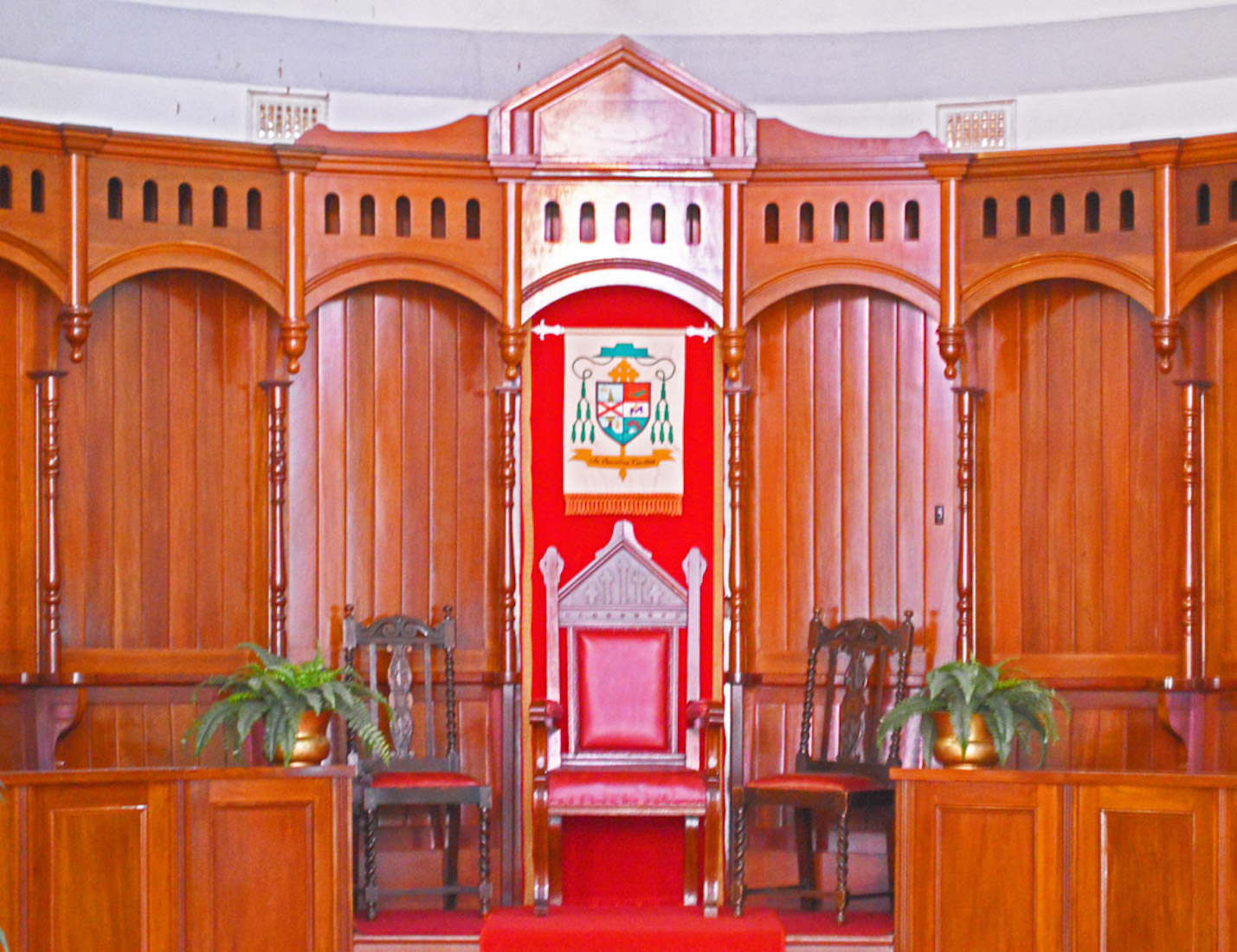
The curved wall of the apse is fitted with a series of timbered alcoves. The central one contains the Bishop’s throne or cathedra. This Latin word is where our word ‘cathedral’ comes from. Above the throne is a small banner containing a coat of arms. The underlying text reads: In Omnibus Caritas or ‘In everything charity’.
43. APSE CRUCIFIX
Above the sanctuary area hangs this Crucifix ... . This is often called the Rood Cross, using an old Anglo-Saxon word meaning ‘rod’.
44. ORGAN
We now look across to the North transept. I have some personal reservations about placing the organ in a transept (rather than in an organ loft), but the organ certainly looks grand in this setting. We also notice the text around the top of the Crossing – the words of Jesus in Matt 16:18, 19 : You are Peter and on this rock I will build my church ... I will give you the keys of the Kingdom. These words and the statue of Peter place a strong Cathedral emphasis on Peter.
45. BESIDE THE ORGAN
We might expect a chapel off the North transept, symmetrically placed to the Our Lady Chapel on the South side. Instead we find this rather cramped ‘Chapel of the sacred Heart of Jesus’ tucked away next to the organ. I suspect this may not have been in the original plans of the Cathedral.
47. TRANSEPT WINDOW
This window is on the West wall of the North transept. The top panel is given in memory of Most Rev Alfred Joseph Gummer – Fourth Bishop of Geraldton 1943 – 1962. The bottom panel is given in memory of Most Rev James Patrick O'Collins, Third Bishop of Geraldton 1930 – 1941.
48. NORTH AISLE
We are about to make our way West along the North aisle. At right we see a special stained glass window, then a statue of St Joseph holding the young Jesus. Two further windows appear at left, and we observe the Stations of the Cross on the North wall, and the small gold crosses by the arches.
49. NORTH NAVE WINDOW
This window lies just East of the statue of St Joseph and Jesus. The bottom panel shows Jesus emerging from the tomb while the guards sleep. The flag is something of a mystery! The middle panel depicts the Ascension of Christ – Christ rising up through the clouds while the disciples watch on. Bottom text: This window is dedicated to the memory of the Father, Mother, Brothers and Uncle of Thomas M. Nilfin *** Requiescant in Pace.
50. JOSEPH AND JESUS
Next to the window is this pleasing statue of St Joseph holding the boy Jesus. Joseph holds a budding branch in accordance with an old legend. The Golden Legend, which derives its account from the much older Gospel of Pseudo-Matthew, recounts how, when Mary was 14 (and living in the Temple), the high priest gathered together all the male descendants of David of marriageable age (including Saint Joseph, though he was much older than the rest) and ordered them to bring a rod. Whoever’s rod blossomed into flower would become Mary's husband. After the Holy Spirit descended as a dove and caused Joseph's rod to blossom, he and Mary were married according to Jewish custom.
51. NORTH WINDOW 1
The bottom panel shows Jesus bearing His Cross, and being ministered to by a woman – perhaps Veronica who wiped Jesus’ face (Station of the Cross VI). The middle panel shows the Crucifixion with Jesus on the Cross, and his Mother Mary and St John standing close by. The top curved panel shows the reclining Lamb holding a staff attached to a small shield with a red St George cross. ‘Pray for the souls of H. N. N. Silcock In loving memory of whom this window was given by her sons and daughters R.I.P’ .
52. NORTH WINDOW 2
In the top curved panel, the soldiers mock Jesus. The middle panel depicts the flogging of Jesus before the Crucifixion. The bottom panel shows a scene from the Garden of Gethsemane, with Jesus praying, two disciples asleep, and an angel watching over the scene. The banner at the base of this window reads: In memory of William Bernard Kelly DD, First Bishop of Geraldton. This window was given by the Priests of the diocese. AD 1922 Requiescat in Pace.
53. ST FRANCIS XAVIER
Francis Xavier was born of a noble family of Basque stock in 1506. During his studies in Paris, he became involved in the small enthusiastic band that was organized by Ignatius of Loyola into the Society of Jesus. He and Ignatius were ordained priests in Venice in 1537. The following year Francis went to Rome, where he helped prepare the foundation of the Society of Jesus. While in Rome, Xavier volunteered to fill a vacancy in a Portuguese delegation to eastern Asia. He spent from 1542 to 1549 in India, Ceylon, Malacca, and eastern Indonesia. In 1549 Japan became Xavier’s mission field. He later tried to smuggle himself into China, but died off the Chinese coast in 1552.
54. LADY OF PERPETUAL SUCCOUR
Further West along the North aisle we come to the icon ‘Our Lady of Perpetual Succour’, also known as ‘Our Lady of Perpetual Help’. This is a title given to the Blessed Virgin Mary by Pope Pius IX, associated with a celebrated Byzantine icon of the same name dating from the 15th century. The icon has been in Rome since 1499, and is currently in the church of Sant' Alfonso di Liguori all'Esquilino. [Text: S. Maria de Perpetuo Succursu. Our Lady of Perpetual Succour Pray for us Memorial of the (THS?) Mission Sept 1918.]
55. ST PATRICK
Moving to the West wall we find the familiar figure of Saint Patrick. St Patrick was a Christian missionary, generally recognized as the Patron Saint of Ireland. Two authentic letters from him survive, from which come the only generally accepted details of his life. When he was about 16, he was captured from his home by Irish raiders and taken as a slave to Ireland, where he lived for six years before escaping and returning to his family. After entering the Church, he returned to Ireland as an ordained bishop in the north and west of the island, but little is known about the places where he worked. By the seventh century, he had come to be revered as the patron saint of Ireland.
57. WEST HIGH WINDOWS
The two stained glass windows over the choir loft were installed to mark the Centenary of the arrival of the Presentation Sisters in Geraldton in 1891. They are a tribute from the Diocese of Geraldton to the work of the Sisters during 100 years. The left window shows the four founding Sisters of the Irish Order of Nano Nagle in 1775 bathed in the radiance of the Holy Spirit as they stand by the well of living water. The second window depicts the founding of the Australian Chapter in Geraldton in 1891. There is a blazing sun with the Southern Cross, a sailing ship, and the cathedral in a sandy waste.
58. WINDOWS PLAQUE
This bass plaque gives a detailed description of the two windows in the choir loft.
59. ARCHITECT JOHN HAWES
John Cyril Hawes 1876 – 1956, was born in England, to a religious family. His boyhood interests included History, Architecture and Drawing and he went to King's College in Cambridge. Even in 1889, he had a leaning towards the Church, but his father wanted him to become an Architect, which he did in 1897. ... By 1908 he had been ordained as an Anglican Priest and travelled to the Bahamas as a Protestant Minister. ... In 1915 John was ordained as a Catholic Priest in Rome, and shortly afterwards he went to WA arriving at Mount Magnet, Geraldton. He was named as a Monsignor in 1937, and again returned to England in 1939, travelling via Rome where he asked permission to adopt the life of a hermit and his wish to carry out some Missionary work in the Bahamas. This was granted. [Photo Cedit: http://www.findagrave.com/cgi-bin/fg.cgi?page=gr&GRid=28142819]
60. PLAQUES
The most productive architectural period of Hawes’ life was spent in WA after arriving in 1915. The following year he was recalled to Geraldton to begin work on St Francis Xavier Cathedral. The first stage of the cathedral was completed in 1918 but following the death of Bishop Kelly work was halted, due to the succeeding Bishop’s opposition to the project. Work did not recommence until 1926 and it was another twelve years before the magnificent cathedral was completed and officially opened in 1938. During his time in the Mid West, Hawes was responsible for an astounding body of work throughout the region, with the design and construction of many other buildings.


